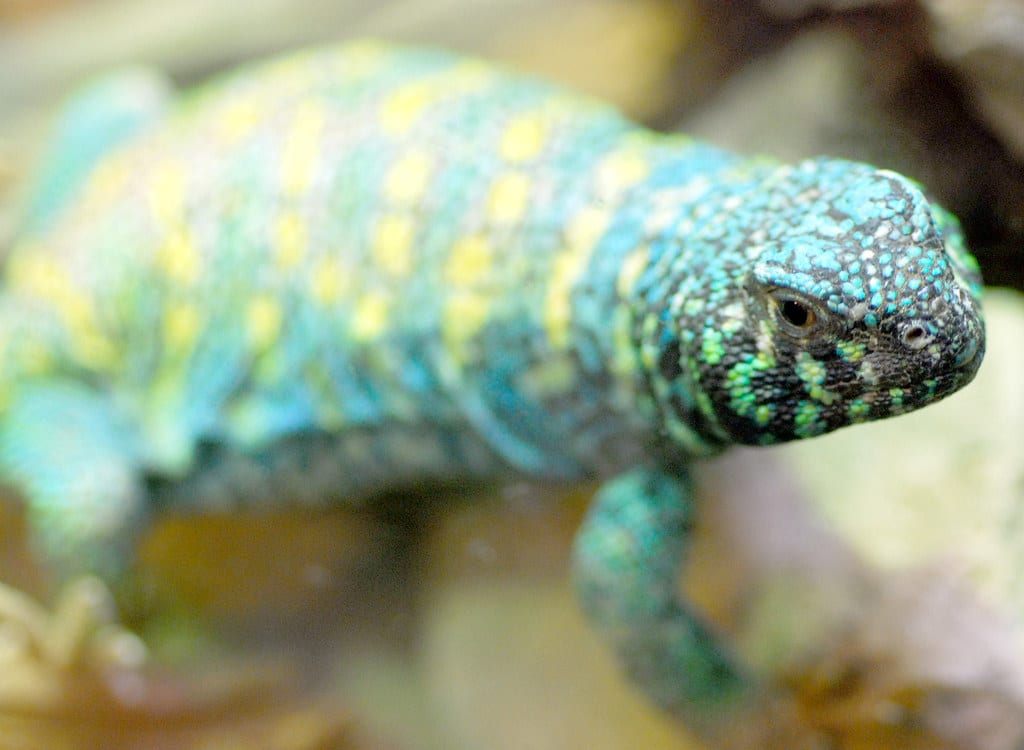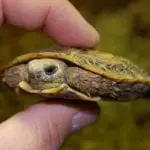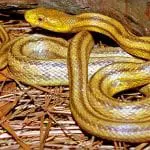Scientific Facts
| Common Name | Ornate Uromastyx |
| Scientific Name | Uromastyx ornata |
| Captive Lifespan | 12 to 20 Years |
| Size | 12 – 15 inches |
| Mass | 9 oz. |
| Habitat | Desert; rocky areas |
| Country of Origin | Egypt, Saudi and Northern Arabia, Israel |
Physical Description
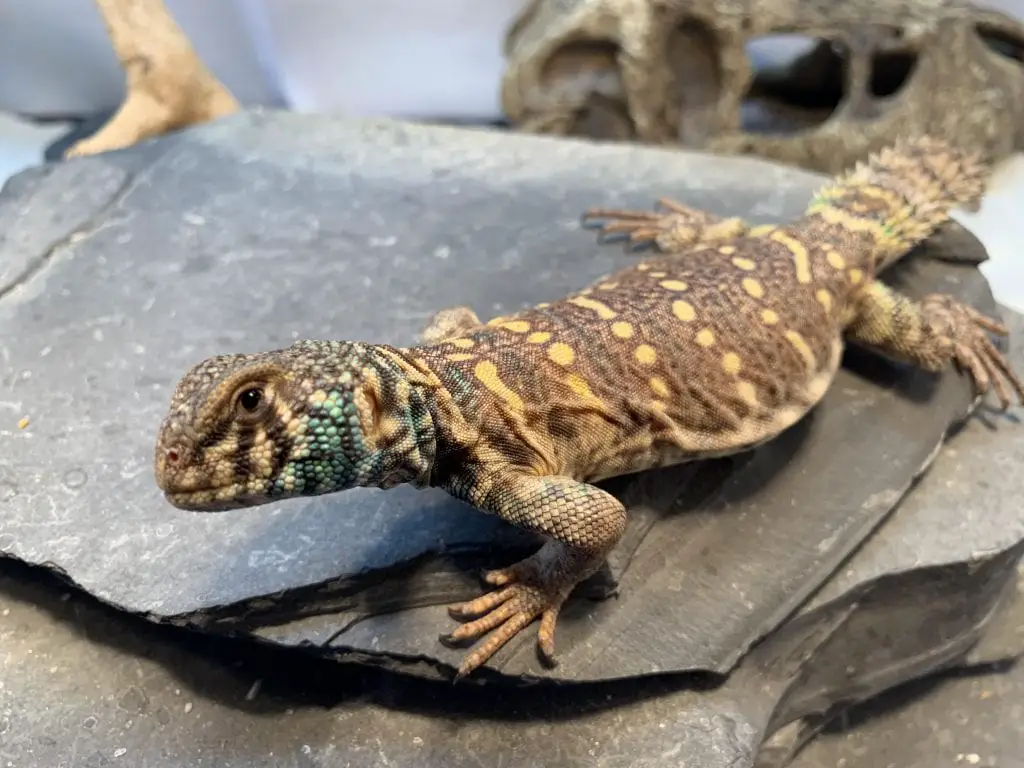
Also commonly referred to as spiny-tailed lizard and Ornate Mastigure, the Ornate uromastyx is a medium-sized lizard. Adults usually attain an average length of 14 inches, although there are reports of adults reaching 16 inches.
These incredible lizards are “equipped” with distinctly spiny tails. The tail is actually used for defense, capable of blocking crevices and burrow entrances alike, allowing Ornate uromastyx to take refuge as needed.
These lizards are characterized by short, yet powerful legs and a bulky body.
Similarly to other Uromastyx species, males tend to be leaner, somewhat slender, as compared with females.
Being sexually dichromatic, the base body colors that can be seen on the backs of males vary from blue, green, and occasionally red, while females are known to exhibit more neutral, light nuances of yellow-brownish to pinks. Also, it is during the breeding season when mature, adult males are to become exceptionally colorful.
What is common for both males and females is that yellow ocelli are exhibited on the lizards’ backs.
Note that not all males are extraordinarily colorful, as some can display much more impressive, striking, saturated colors than others.
Before Ornate uromastyx lizards achieve their full color, it takes anything from three to six years.
Even though occasionally, female ornates can also be especially extremely colorful. This rare phenomenon is referred to as “male mimics.”
Types
Belonging to the Old World lizard family Adamidae, suborder Iguania, there are between 19 and 22 species of Uromastyx, with the precise number being hard to tell because of the re-classifications taking place, with some of these lizards being redirected from the genus Uromastyx to the genus Saara in the recent years.
Ultimately, there are at least 18 different Uromastyx species that have been officially recognized by a taxonomist, and there are also more existing varieties and subspecies.
Although there used to be eighteen Uromastyx species at one time, it was back in 2009 when three subspecies received full species status.
As of the time of writing, the species and subspecies of Uromastyx include U. aegyptia leptieni (aka Egyptian mastigure), Uromastyx benti (Bent’s mastigure), U. aegyptia microlepis, Uromastyx alfredschmidti (Schmidt’s mastigure), U. dispar flavifasciata and U. dispar maliensis (Mali Uromastyx), U. dispar dispar, U. dispar hodhensis, Uromastyx macfadyeni (Macfadyen’s mastigure), Uromastyx occidentalis (Giant spiny-tail lizard), Uromastyx nigriventis, Uromastyx geryi (Saharan spiny-tail lizard), Uromastyx princeps (princely mastigure), Uromastyx shobraki, Uromastyx yemenensis (Yemen spiny-tail lizard), Uromastyx ocellata (eyed dabb lizard), Uromastyx thomasi (Oman spiny-tail lizard).
The two subspecies of Ornate Uromastyx include U. ornata ornata (Ornate mastigure), and U. ornata philbyi.
Apart from the existing Ornate Uromastyx subspecies in the wild, captive breeding has greatly contributed to the development of strikingly beautiful color morphs.
For instance, it is thanks to captive breeding how experts have managed to develop deeper green instead of blue coloration, as well as to succeed in enhancing the usually muted red coloration.
Also, there are hypomelanistic Ornate Uromastyx varieties, with the black color being reduced as to give way to other colors appearing more vivid in return. Not the least, there are hypermelanistic Ornate Uromastyx varieties, with their pigmentation being darker overall, and with visibly thicker black markings.
Habitat & Lifespan
Originating from the desert regions of northern and Saudi Arabia, Israel, and Egypt, Ornate Uromastyx is known to occupy “wadi,” referring to the dried water routes located between cliffs. Also, these lizards occupy the bed between mountains where clay, silt, and sand have been deposited due to floodwater flowing in the local rivers’ deltas and valleys (aka alluvim bed), hidden among rocks, as well as in cracks.
Ornate Uromastyx lizards are capable of adapting to rocky desert habitats where temperatures are high, vegetation is scarce, while rainfall is rather low.
They can be found on rocky surfaces and firm soil, where sheltered crevices provide safety from potential predators. The species can be occasionally seen climbing Acacia trees, yet it can rarely be spotted spending time on the sand.
Not that long ago, it used to be quite a complicated task to accurately estimate the average captive lifespan of Ornate Uromastyx, as well as other species of Uromastyx alike, as most of these lizards were not captive-bred but imported after being caught in the wild.
Up-to-date, thanks to the ongoing success of captive breeding practices, experts point out to the approximate lifespan of captive Ornate Uromastyx being set at between 12 to 20 years, with 15 years being the most typical lifespan rates.
However, there are existing reports of Uromastyx lizards exceeding 30 years of age, with the U. Aegyptius demonstrating the longest lifespan, apart from being the largest in the genus.
Behavior
In order to escape the desert heat, Ornate Uromastyx lizards are to dig burrows. They also dig burrows when it comes to egg-laying.
Commonly considered the “couch potato” of Uromastyx species, adult Ornate Mastigures are typically quite sedentary, preferring to spend most of their time engaged in eating and basking throughout the day.
However, juveniles actually demonstrate quite the opposite behavior, as they are masters of climbing, and are extremely active.
When it comes to keeping this lizard as a pet, the Uromastyx Ornate has the reputation of being very docile, with each lizard having its very own, unique personality.
Caging
1. A single juvenile Ornate Uromastyx under 6 inches in length should be housed in a 20-gallon tank.
2. A single adult Ornate Uromastyx should be provided with at least a 40-gallon enclosure. As a rule of thumb, though, the larger the enclosure, the better, with the major exception that if the caregiver is not able to maintain proper temperatures in a bigger-sized tank than the bare minimum required for housing an adult ornate lizard, then it is better to stick with the recommended minimum.
3. For housing, a single Ornate Uromastyx, or for housing a pair, a 4′ x 2′ enclosure will work equally great.
Important Notes:
Ornate Uromastyx requires an enclosure measuring at least 4 by 2 foot because of these lizards’ thermoregulation needs. Large enclosures allow them to thermo-regulate properly, by being able to move from the cooler to the warmer temperature zones as needed. With this in mind, many keepers actually point out to having better success with using a large, 4 by 2 cage even for newly hatched babies.
4. For cage furniture, using tiles, rocks, branches, and/or caves is strongly recommended. If the caregiver is to make use of branches collected from outdoors, he/she must soak the branches in a light bleach solution prior to arranging them inside the enclosure, or else, the health of the Ornate Uromastyx pet can be compromised.
5. Provide a minimum of three hides per one adult ornate lizard. Better yet provide six, if possible. Apart from utilizing commercial-grade wooden and/or clay hides, keepers can embrace a DIY attitude and invent fantastic hides using pipes and tubes that are widely available in just about any hardware store.
6. For babies and juveniles, common toilet paper rolls, as well as paper towel rolls, can make wonderful and especially affordable hides.
Substrate
1. Newspaper is one of the best choices when it comes to selecting an appropriate, affordable, and easy to maintain substrate for your Ornate Uromastyx pet. Certainly, the newspaper is not the most natural-looking bedding, and neither is it the most aesthetically pleasing one, but considering some of the drawbacks of other substrates, it really makes a fairly good and fairly practical option.
2. It is possible to leave the bottom of the case 100% bare. In the absence of any substrate at all, the caregiver can rest assured that the lizard will not accidentally get to ingest substrate, as this can lead to nasty health issues in return. However, a bare cage bottom is not very practical, since whenever the lizard is to have a bowel movement, the pet will then get to smear feces literally all over the cage’s floor, and nonetheless, on its very own belly, while walking from point A to point B.
Heads Up
Cleaning services related to the maintenance of tile, rock and bare-floor enclosures alike can become especially elaborate for keepers planning to take care of numerous Ornate Uromastyx in separate cages. For those who intend to keep their collection of ornate lizard pets to only a few of these beautiful reptiles, though, leaving the floor of the enclosure bare can actually make a very good choice.
3. Ornate Uromastyx keepers can use play sand as a suitable substrate. Do make sure to wear a face mask when sifting and stirring play sand, though.
4. Millet makes a great option, as long as the caregiver does not plan to breed the reptiles since if a female is to lay eggs on millet, it is virtually impossible to dust off the eggs. Finally, if the breeder is to then place the eggs in an incubator, the millet will get to sprout within only a couple of days, damaging the eggs as a result.
5. Stay away from crushed walnut shells and calcium sand. Both of these can lead to intestinal impaction, and intestinal impaction can be lethal to your Ornate Uromastyx.
6. Keepers want to use enough substrate to cover the enclosure’s bottom to about ¼ to ½ inch of depth. Next, add several sandblasted pieces of grapevine, as well as edged rocks (not sharp!) and/or ceramic tiles. To build up basking areas, you can aquarium silicone to safely set tiles/rocks/grapevine together.
Temperature, Lighting & Humidity
1. All Uromastyx species, including but not limited to Ornate Uromastyx, are known to absorb heat from above and not from below. Because of this, using under-tank heaters to maintain proper temperature is NOT recommended, as Ornate Uromastyx may get themselves burnt, especially since they are quite lazy lizards, taking them some time before they feel utterly uncomfortable so that they decide to finally move away from the under-tank heater, although it can be too late and they may have already injured themselves.
2. To be able to properly digest their food, as well as to thermo-regulate as desired, ornates’ enclosures have to be provided with a temperature gradient. Place basking lights at one end of the cage, keeping temperatures within the 120 and up to 130 degrees Fahrenheit range. On the cooler end of the enclosure, maintain temperatures between 80 and up to 90 degrees Fahrenheit.
3. At night, the ambient temperature should be dropped down to about 70 degrees Fahrenheit. Only use ceramic heating elements, keeping in mind that night bulbs, as well as red bulbs alike, can disturb the reptile’s circadian rhythm.
4. To easily decrease or increase basking temperature at the warmer end, caregivers can simply lower, or respectively, raise the basking light. Always make sure that the lizard will not be capable of getting in direct contact with the light in order to avoid nasty burns.
5. Both the all-in-one type of heat + UVB emitting mercury vapor lights (or alternatively high UVB output fluorescent tubes), as well as separate UVB lights and heat lights, can be utilized accordingly by the keepers, with the choice between these options being mostly a matter of personal preferences.
6. Turn the lights ON when the sun rises (better yet, use a timer to set them automatically switch ON), and turn the lights OFF when the sun goes down.
7. Please, mind that UVB fluorescent lights must be replaced regularly every 6 and up to 12 months, or else, they will not remain effective, causing the lizard potential harm because of not having sufficient exposure to UVB light.
8. As the Ornate Uromastyx originates from desert habitats, this lizard does not require humidity. The enclosure should not be misted but should be maintained on the dry side instead.
Diet
As with other herbivores, the diet of Ornate Uromastyx consists of various vegetation.
Eating Habits
1. One of the best advantages related with the eating habits of Ornate Uromastyx is that the caregiver does not have to mess with insects, but instead, he/she should simply provide a balanced, varied diet, majorly consisting of various dark leafy greens, among other vegetation, including veggies and edible flowers.
2. Feed adults 2-4 days weekly with a high-quality mix of edible flowers and greens. Although only optional, you can dust these food items with D3 calcium supplement once a month. Do not overdo D3 calcium food supplementation, since these lizards will properly metabolize both Calcium and Vitamin D3, as long as they are provided with UVB and proper diet.
3. Provide a small bowl filled with a variety of raw, ground-up lentils, beans (remove red kidney beans, though), birdseed, and green peas every other day. Do not offer these food items to Ornate Uromastyx below 6 months of age, though. Every 10 days or so, you can also add pure bee pollen granules to the mix of beans, peas, birdseed, and lentils.
4. Keep food items away from the sand substrate if using such! Instead, offer flowers, veggies, and fresh greens on an appropriately-sized tile (12-inch square should do great).
5. As a rule of thumb, most of the flowers, greens, grasses, and veggies that can be fed to tortoises are also safe to offer to your Ornate lizard pet.
6. Some of the greens you can feed to an Ornate Uromastyx include a combination of collard greens, microgreens, mustard greens, endive, bok choy, turnip greens, mesclun, arugula, spring mix, escarole, dandelion greens, and endive. You can also offer kale but only in moderate amounts.
7. Suitable herbs to offer to your ornate pet include garlic chives, parsley, sage, and basil, among others.
8. Some of the edible flowers your Ornate Uromastyx pet will gladly feast on include day lily, hibiscus, dahlia, marigold, mustard flower, rose petals, geraniums, violet flowers, pansies, hollyhock, pumpkin flower, chrysanthemum, dandelion, nasturtium. The best way to go is to organically grow your own edible flowers, always making sure to pull them apart in smaller pieces and thoroughly wash them with clean water prior to offering them to the lizard.
9. Ornate Uromastyx will also happily snack on various fresh grasses, such as Bermuda grass and timothy hay.
10. Even though feeding these lizard pets with just about any organic spring mix widely available in every grocery store will do fine, it is really important to provide them a varied, balanced diet, and this is best achieved by growing suitable herbs, grasses, and edible flowers yourself.
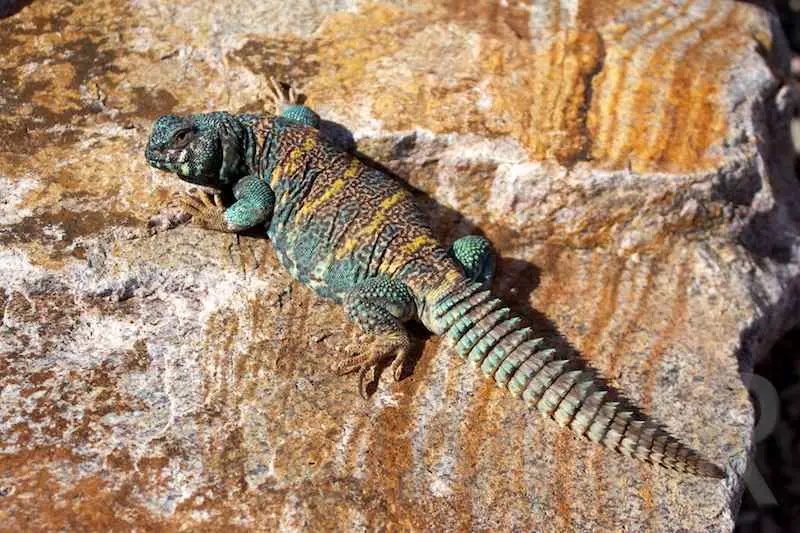
Sleeping Habits
Ornate Uromastyx is a diurnal creature, and it is during the day when they become active. These lizards do not hibernate.
Water
Being desert creatures by nature, adult Ornate Uromastyx do not drink from a water bowl. These lizards fully satisfy their water needs through the food they consume.
However, hatchlings should be provided with a suitable water container, such as a shallow jar, filled with fresh, clean water every other day.
Development and Reproduction
Ornate Uromastyx reaches sexual maturity at the age of between 2 and 4 years old.
Adult males become visibly more colorful as the breeding season kicks in. The mating process of these lizards can sometimes be very violent.
If mating is successful, the female is to lay eggs within 4 and up to 6 weeks after copulation. Each clutch can be made up of anything from as few as 4 and up to 20 eggs. The size of the clutch greatly depends on the female’s age, health, and size.
How to Breed
1. As a rule of thumb, Ornate Uromastyx breeding enthusiasts need to know that if a female has been used to growing up alone, then she will tend to be especially hard, if willing at all, to pair up with a male partner.
2. It is easy to tell males from females, as males are much more colorful. If a V-shaped row of scales is present right below the lizard’s vent opening, then you are dealing with a male, as this V-shaped row is not present in females. Not the least, the head size and shape of males is somewhat broader than that of females.
3. As ornate females reach sexual maturity, they take on much more of a pear shape than the body shape they used to have when still immature, with a distinct flap of skin located on their necks, for the purpose of males being able to grab onto that flap during the peak of the mating process.
4. To encourage breeding, it is best to put Ornate Uromastyx through only a light brumation.
Firstly, cut down the hours of light the lizards receive per day to six hours at the beginning of December. Secondly, cut the light hours per day to 4 hours throughout the second half of December and all the way to the end of January. At the very beginning of February, you can restore the lights to running ON for eight hours a day for two weeks. Finally, restore the lights to running 12 hours per day up until the end of February when it is time to place males and females together.
5. In the case of successful breeding, the female is to lay eggs within the course of 4 – 6 weeks.
6. At least a month prior to the female possibly laying her eggs, the breeder should provide an egg-laying box, lined with a mix of organic dirt and sand. Place the box on the cooler side of the enclosure, allowing the female to get well-used to this foreign object.
7. The breeders can notice that the female has laid eggs as she will become visibly thinner afterward. Even though egg laying is somewhat exhausting to females, they typically start to resume normal basking and feeding, as well as gain back their weight, within less than a month after depositing the eggs.
8. It is best to rubber gloves when removing the eggs from the laying box. Be careful when gently transferring them into incubation containers (plastic ones work great). Make sure to place them in the very same position as they were laid.
9. Space the eggs in about 1 inch apart, and place them in well-moistened perlite, making sure to squeeze out any excess moisture from perlite. The goal is that the perlite it damp enough to form a clump when squeezed between your palms.
10. Incubate eggs at 92 degrees Fahrenheit for 50 days. Afterwards, increase the incubation temperature to 93 degrees Fahrenheit. Check on the eggs regularly, so that you can act accordingly by raising humidity quickly as needed. Eggs should hatch within 60 and up to 70 days.
Handling
1. It is only true to state that Ornate Uromastyx may or may not enjoy being handled, although it is certainly possible to handle them. Most of the species are known to gradually relax over time, as they become better acclimated to interacting with their caregiver, and in return, getting better acclimated to being handled, too. However, if not given the time and care to get well-used to being handled, these lizards may grow into adults that generally feel nervous during handling practices.
2. As a rule of thumb, every caregiver can teach his/her Ornate Uromastyx companion to be handled, as long as the reptile is given the needed time to adjust.
3. Avoid handling newly acquired Uromastyx within the first month of their arrival in the enclosure. Allow them to get familiar with the new environment, and do not cause them any additional stress, which is exactly the case with starting to handle them too soon.
4. When ready to start handling practices, begin by placing your hand inside the enclosure. Do not hurry handling the Ornate Uromastyx yet! Instead, slowly move your hand closer and closer to the lizard over the course of a week or so.
5. By the end of the week, your Ornate Uromastyx pet will most likely at least allow you to touch him/her without running away from you. Success! Now, you want to remain patient and not force the reptile to be handled. Instead, let your hand rest on the back of the lizard for as little as a few minutes at a time, without any sharp, sudden moves or excess petting, just leave it resting.
6. Over time, you will be able to move your hand beneath the lizard’s body without getting the animal to feel stressed or nervous. Once your hand is securely placed beneath the reptile, you can gently and carefully lift it, placing it onto your palm.
7. When handling your Ornate Uromastyx fellow, always make sure to fully support the entire lizard’s body. Do not be afraid or hesitant to let the reptile’s hands grasp your palm and/or arm; in this way, the animal will feel more secure.
8. At the beginning of the handling practices, when the lizard will still sometimes try to escape, as well as to occasionally squirm, it is best to ensure that you only hold the reptile over something soft, such as a pillow. By doing so, the lizard will be able to safely land onto the soft object if needed, as you must never squeeze or otherwise force the reptile to stay in your hands in the case it obviously wants to getaway!
9. Patience is key. Once a solid bond has been established between the keeper and the Ornate Uromastyx, the lizard will allow being handled with rarely ever struggling or feeling nervous. It is the keeper’s responsibility to gain the reptile’s trust and to always treat the creature with care and respect.
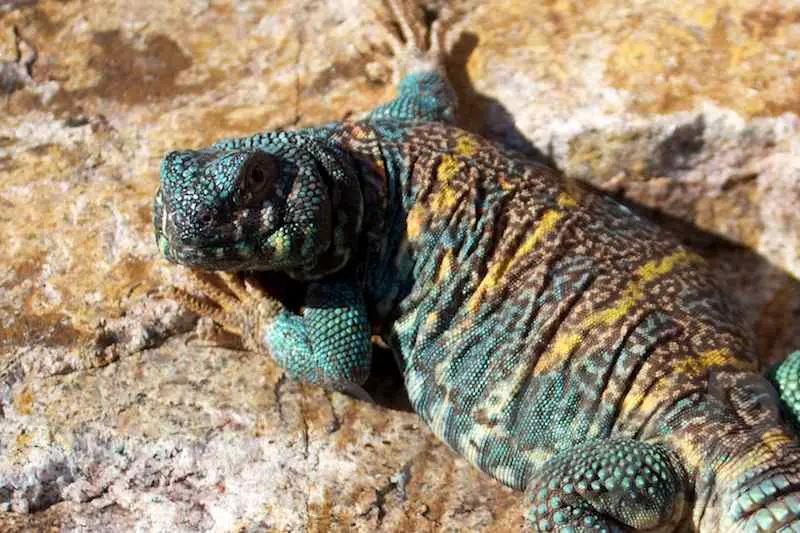
How to Treat and Prevent Possible Health Issues
1. Do not expose Ornate Uromastyx to high humidity levels. The enclosure, as well as the substrate, should be kept dry at all times to avoid toe infection issues, as well as dry skin problems.
2. Avoid feeding fruit high in oxalates, such as star-fruit. Also, mind that some fruits are strongly skewed towards phosphorus in Ornate Uromastyx lizards’ Calcium to Phosphorus levels, so these fruits, including peaches, nectarines, plums, passion fruit, and bananas, should be only fed occasionally, and in moderation.
3. If you notice that your Uromastyx pet is licking or tasting the substrate, do not fret, as this is actually normal behavior. However, in the case you notice that your lizard pet is regularly eating significant amounts of a substrate, then you must immediately pay attention. Such behavior can often be a sign of incorrect amounts of calcium and vitamin supplementation in the reptile’s diet.
Possible Dangers to Humans
These lizards are rarely reported to bite. They will only do so if feeling severely threatened. Since this lizard species lack venom glands, any possible bites are not fatal for humans.
With careful handling and proper care, your Ornate Uromastyx will never attempt to bite you.
Availability: How to Get an Ornate Uromastyx?
The Ornate Uromastyx is currently listed in Appendix II of the CITES, which allows for these lizards to be collected from the wild and exported to certain locations across the globe.
As with other reptiles, though, opting for captive-bred Uromastyx ornate is always strongly encouraged. You can get this lizard from various local pet stores. Alternatively, you can also check out reputable online pet traders.
Fun Facts
1. The genetic difference between Uromastyx ornata and Uromastyx philbyi (aka Arabian Blue Uromastyx) is only 0.7 %!
2. It is by licking how Ornate Uromastyx explore their surroundings in a similar sense as a person would inquisitively smell a particular item in order to receive information about it. As soon as the caregiver is to place a new object within the enclosure, the lizard pet is sure to come up and lick it!
3. It wasn’t before 2000 when Ben David Osnat and Danny Molco finished and published research that lasted for 4 years, concluding that Uromastyx ornata is actually herbivore, as prior to the research being completed, these lizards were thought to feed on various insects. After thoroughly analyzing their droppings, the researchers managed to find out that they consisted of as little as 1% insects, predominantly ants, which were certainly consumed by accident while the reptiles were feasting on flowers in the wild.
4. In the wild, these lizards are known to live either alone or in small groups made up of only one single male and several females.
5. The mating behavior of U. ornata, similar to other Uromastyx, can be quite violent. Usually, mating begins with the male demonstrating various circling behavior, as well as “push-ups.” If the female is not ready to breed, she may flip over, but this might not stop the sexually determined male, bluntly biting onto the fold of the female’s skin in the neck zone, and hanging on to it. The male is to hold the female in a mating position for 2 and up to 10 minutes.
How to Take Care of an Ornate Uromastyx
1. Do never cohabitate different species of Uromastyx in the same cage. However, housing a group of Ornate Uromastyx in the same enclosure is possible, although this does not always work very well. It is often the case that a pair of male and female ornates will fail to get along, and so they will have to be separated as not to cause each other harm, and to be only introduced within the same enclosure during breeding practices. The safest bet is to keep these lizards singly.
2. If you are to opt for wild-caught Ornate Uromastyx, mind that they are known to acclimate better in cages with glass only in front, and three solid walls, made from plastics, PVS, or wood.
3. Depending on how extensive the caregiver is willing to make the enclosure, building a network of crevices and tunnels by using rock pieces is highly recommended. By building such a network, you will provide the lizard with an environment that is as close as its natural habitat in the wild, so that the reptile can crawl out and in the tunnels, living up to its fullest potential.
4. Decorating the enclosure with sandblasted grapevine is not only aesthetically pleasing, but also serves quite practical purposes, as it allows the lizard to rub against it when shedding skin as to ease the process, and it also allows the animal to practice its climbing skills.
5. Keep the photoperiod consistent with outside lighting. Mind that during the wintertime, Ornate Uromastyx can greatly benefit from being introduced to a brumation period lasting for 8 and up to 12 years.
FAQ Section
Does Ornate Uromastyx Make Good Pets?
As long as proper care is provided, Ornate Uromastyx can make wonderful pets. Also, Ornate Uromastyx can make excellent pets for children, as these non-venomous, docile, friendly, curious, and amusing vegetarian lizards are capable of teaching minors invaluable lessons about dedication, respect, and patience.
Are Ornate Uromastyx Good Pets for Beginners?
In general, several Uromastyx species are considered beginner-friendly pets, especially since feeding is way much easier as compared to other lizards, due to their vegetarian diet. However, the Ornate Uromastyx care level is considered advanced, so for newbie reptile enthusiasts, this may not be the best choice to start with.
What Do You Feed an Ornate Uromastyx?
Similarly to other species of Uromastyx, the Ornate Uromastyx is herbivorous and should be therefore fed with various green plants, depending on their availability based on both season and location. Bok choy, commercial-grade spring mixes, dandelion, and collard greens, endive, radicchio, as well as escarole, dried lentils, peas, and seeds are suitable examples of food that an Ornate Uromastyx will adore, thriving healthy and happy.
How Long Can Uromastyx Go without Food?
In the wild, Uromastyx is known to be able to go without food for weeks, and even months, thanks to these lizards gaining and then storing most of their energy. For Ornate Uromastyx raised in captivity, though, there is no reason for the dedicated caregiver to allow the reptile to starve!
How Often to Feed Uromastyx?
Feeding your Ornate Uromastyx pet between 2 – 4 times every week is enough to keep the reptile healthy and happy. Although it may be tempting to feed it daily as to enjoy more interaction with your lizard pet, this is not needed and should be best avoided.
Can Uromastyx Eat Fruits?
Fruits should only be fed to Ornate Uromastyx in very small amounts, some suitable fruits being watermelon, peaches, pears, grapes, apples, strawberries, cantaloupe, and raisins. Always make sure to cut the fruit in pieces small enough for the lizard to eat them effortlessly, and only provide them as occasional treats once or twice a month.
Why Is my Ornate Uromastyx not Eating?
If your Ornate Uromastyx is not eating, you need to pay immediate attention to the reptile. Ornate Uromastyx may refuse to take food because of improper lighting/temperature within the enclosure, as well as because of possible mouth infection, gut impaction, parasites, or upper respiratory infection.
Do Ornate Uromastyx Need Water?
Ornate Uromastyx, like most species of Uromastyx, get their daily water needs fulfilled through their food. While hatchlings should be provided with a Tupperware lid of water every other day, adults will not drink from a water bowl, unless when it comes to sick individuals, new arrivals, and gravid females, known to occasionally require drinks of water.
Is Ornate Uromastyx Aggressive?
In general, Ornate Uromastyx lizards are not aggressive animals, even though the degrees of aggression can change throughout the reptile’s lifespan. However, the aggression levels exhibited by Ornate Uromastyx may vary from one individual to another, and those raised in group settings are known to show dominance rather early.

